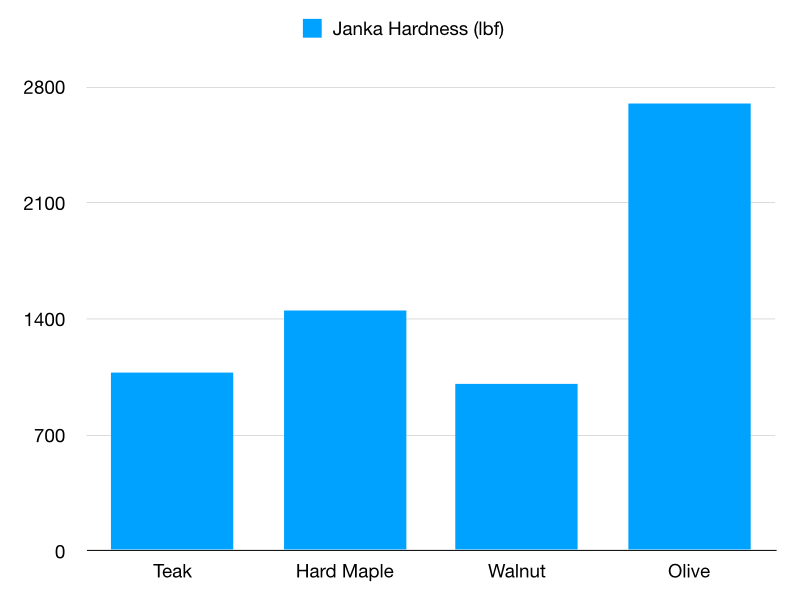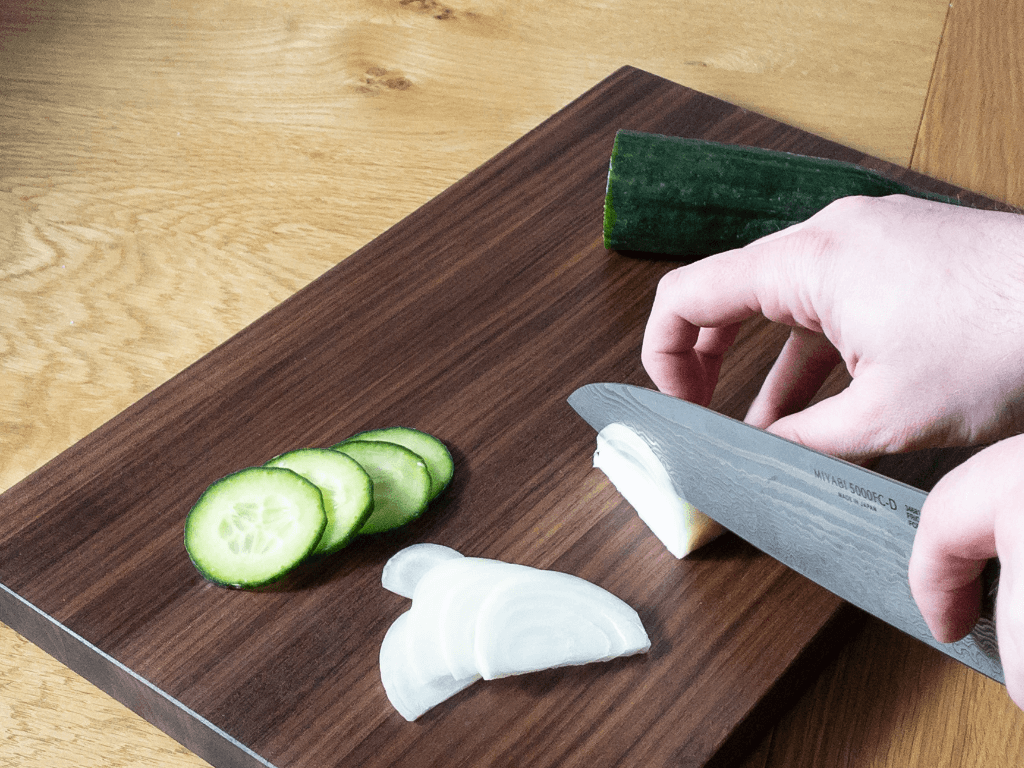Table of Contents
- Best Wood Chopping Boards Must Have Features
- 1. When It Comes to Size Think Big
- 2. If Your Cutting Board is Thin Its Not Long for This World
- 3. Yes, the Wood Species Matter - What you Need to Know
- 4. Chopping Board Pattern - Keep it Classy
- 5. Design Features - To Juice Groove or Not Juice Groove the Age Old Question
- 6. A Silky Smooth Finish
- 7. A little Maintenance Goes a Long Way
- Why a Plastic Board is no Comparison to a Wooden Chopping Board
- If I'm Paying Top Dollar I want Bells And Whistles
Lets Define What A Premium Wooden Chopping Board Looks Like
When talking about premium wood cutting boards, we're referring to the star of the kitchen, the workhorse, your main board. The factors considered are specific to this type of board. We aren't concerned about portability, for example. What we prioritise are factors affecting performance: how chopping feels, whether the surface dulls the knife's-edge prematurely, size - how much real estate you have in your kitchen. To juice groove or not, to add handle grooves or not - there's a lot to consider, based on your wants and needs. A premium chopping board isn't a cheap purchase, but it's an investment in a product that will be used every day and provide the user with a certain satisfaction not found in cheaper, inferior counterparts.
Best Wood Chopping Boards Must Have Features
1. When It Comes to Size Think Big

Chopping boards come in a range of sizes and shapes, so it's important to choose one that suits your needs. An essential in any kitchen - anyone who has spent a reasonable amount of time chopping food on a small, undersized cutting board knows that it makes kitchen prep miserable, or at least uncomfortable. Slicing and dicing with vegetables flying everywhere, often falling off the board and making a mess. Having to move prepped food into bowls to make room for the next item on the chopping block adds time and inconvenience to the cooking process. If you want to make life easier, heed this advice: buy the biggest cutting board you can afford or have room for in your kitchen. Then, you'll have the tools of the trade at your disposal, ready to prepare and deliver healthy and delicious meals for you and your family.
2. If Your Cutting Board is Thin Its Not Long for This World
A thin wooden board is destined to become firewood before its time. Its slimness, lack of weight, and robustness will lead to its early demise. However, a thinner wooden chopping board has a use case as a secondary board for portability, so it shouldn't be dismissed entirely. Look for a minimum thickness of 40mm, with 50mm being the sweet spot. The added thickness provides enough weight to keep the board firmly planted on the kitchen counter, and it adds robustness - a thick wooden cutting board is less likely to warp and has a reassuring quality far less capricious than its thinner counterpart. So don't be tempted by a cheap, thin board, its certainly a false economy in the long term - if you want quality, opt for something thick and sturdy!
3. Yes, the Wood Species Matter - What you Need to Know
When it comes to choosing wood species we have some thoughts. They are not inconsequential, and understanding the characteristics that will affect performance will keep you on the straight and narrow not regretting your purchasing decision.
Desired Characteristics
- Tight closed pores
- As an example, Ash and Oak grain structured is open in comparison to other hardwoods we will mention. The open pores allow for stains to linger, and the knife blade edge to damage board surface much more readily
- Walnut and Teak have closed pore structures along with Maple and Olive are all quality wood choices.
- Janka Hardness measures how hard a wood is and how resistant it is to dents, dings and wear. - Popular woods

For more info on Janka Hardness the Wood Database is a great reference.
- Wood figuration, tone and colour
- The aesthetic appeal cannot be disregarding or overlooked, you have to look and use it everyday so choose a species of wood you love.
4. Chopping Board Pattern - Keep it Classy
The market caters to all comers. Want a chopping board with a Star Wars inlay? I've seen it - your wife and family probably won't appreciate it mind. For us, we recommend purchasing a board that lets the beauty of the grain speak for itself. Nature is an elegant artist theres no need to mix and match woods to make elaborate patterns. It can be done well but frankly, most of the time it's not and these purchases are often regretted a few months down the line once the initial shine has worn off. You'll find lots of unique colourations and intricate grain patterns that satisfy and you won't have to worry about any future kitchen renovations clashing with your cutting boards. Wood in its simplest form pretty much goes with anything.
5. Design Features - To Juice Groove or Not Juice Groove the Age Old Question
We have strong opinions on juice grooves, and it's an emphatic 'no, get out of town' for three reasons.
-
You shouldn't carve meat on your beautiful wood board. You should treat your cutting board with consideration, as extreme fluctuations in heat are not good for it. It's better to have a large plastic board dedicated to carving meat. If you're not cutting meat on your wooden cutting board, then there's no need for juice grooves, right?
-
Juice grooves reduce cutting surface area. We want as much cutting real estate as possible. It's not fun to cut in a constricted area, and you can reasonably expect to lose up to 8% of cutting space when you buy a board with juice grooves.
-
The valleys will capture bits of food during chopping and transferring food from board to bowl for cooking. It's an extra hassle and frustrating enough for us to advise against juice grooves.
6. A Silky Smooth Finish
Sanded to a buttery smooth finish, this allows the knife to glide effortlessly across the board with little risk of chipping those expensive, sharp but brittle Japanese Chef's knives. Not only this, but a smooth finish prevents the accumulation of bacteria, reducing the spread of germs in the kitchen.
7. A little Maintenance Goes a Long Way
Theres a lot of scare mongering about wood cutting board maintenance. Honestly, its not the daunting task its cracked up to be. A little maintenance goes a long way. Regular cleaning with warm soapy water can help keep bacteria at bay do this on the kitchen counter top not in submerged in the sink. When you're finished dry thoroughly. Additionally, treating the wood with mineral oil or beeswax will help protect it from moisture and prevent cracking or warping over time. This can be done periodically, if the board looks dry by all means condition the board but as a rule of thumb 1 monthly is a good estimate.
Fortunately a premium wood cutting board will require less upkeep than a bargain basement board thats likely to be far more temperamental because the wood used is likely unsuitable as a cutting board.
Why a Plastic Board is no Comparison to a Wooden Chopping Board
We should first caveat this statement: plastic cutting boards are great for certain tasks. We recommend having two dedicated plastic boards in all kitchens - one for carving meat and another for preparing raw meat we consider them must haves to round out a versatile chopping board set. While plastic cutting boards are a popular choice in the kitchen, they simply can't compare to a premium wooden board. Sure, they may be cheaper and easier to clean than their wooden counterparts, but plastic boards lack the longevity, beauty, and functionality of wood. And let's not forget the satisfying feel of cutting on a beautiful piece of wood that simply can't be replicated with plastic.
If I'm Paying Top Dollar I want Bells And Whistles
There are chopping boards out there marketed with design gimmicks, like slide-out trays notched into the wood. However, these types of gimmicks come at a cost. The hollowed-out wood will compromise the cutting experience; without the denseness of the wood underneath the blade, you might as well cut on plastic. The satisfaction comes from the blade-to-wood feedback loop, and the density of the wood is a key factor. The price paid comes from the cost of materials, labor, and time to manufacture a quality product that just performs - not trying to be anything other than what it is. Remember, this isn't a Swiss Army Knife, but it's definitely a tool that you'll use every day, so it's important to choose wisely. The upfront investment isn't trivial, so make sure you're happy with your decision.
Shop Premium Wood Cutting Boards
Buy best in class wood chopping boards.




